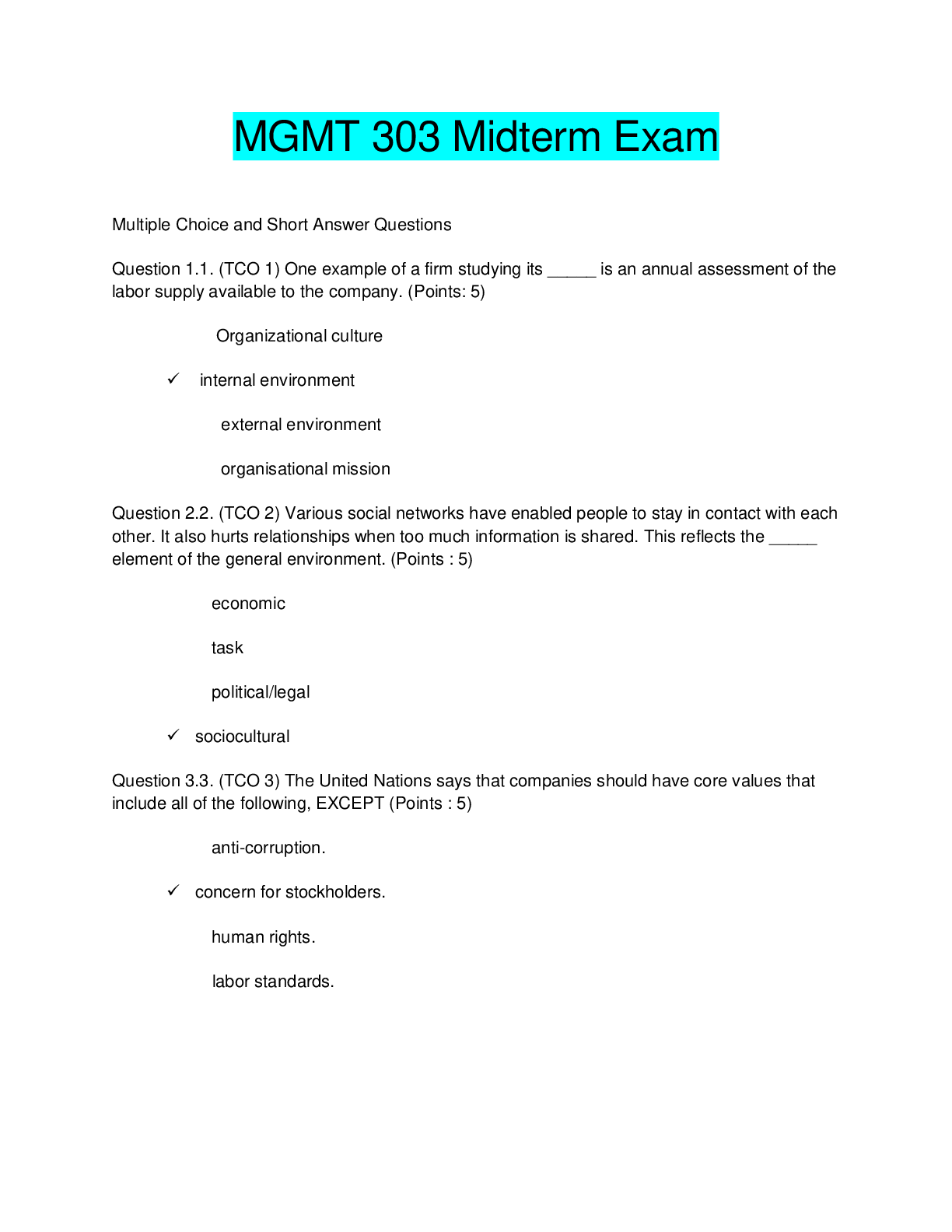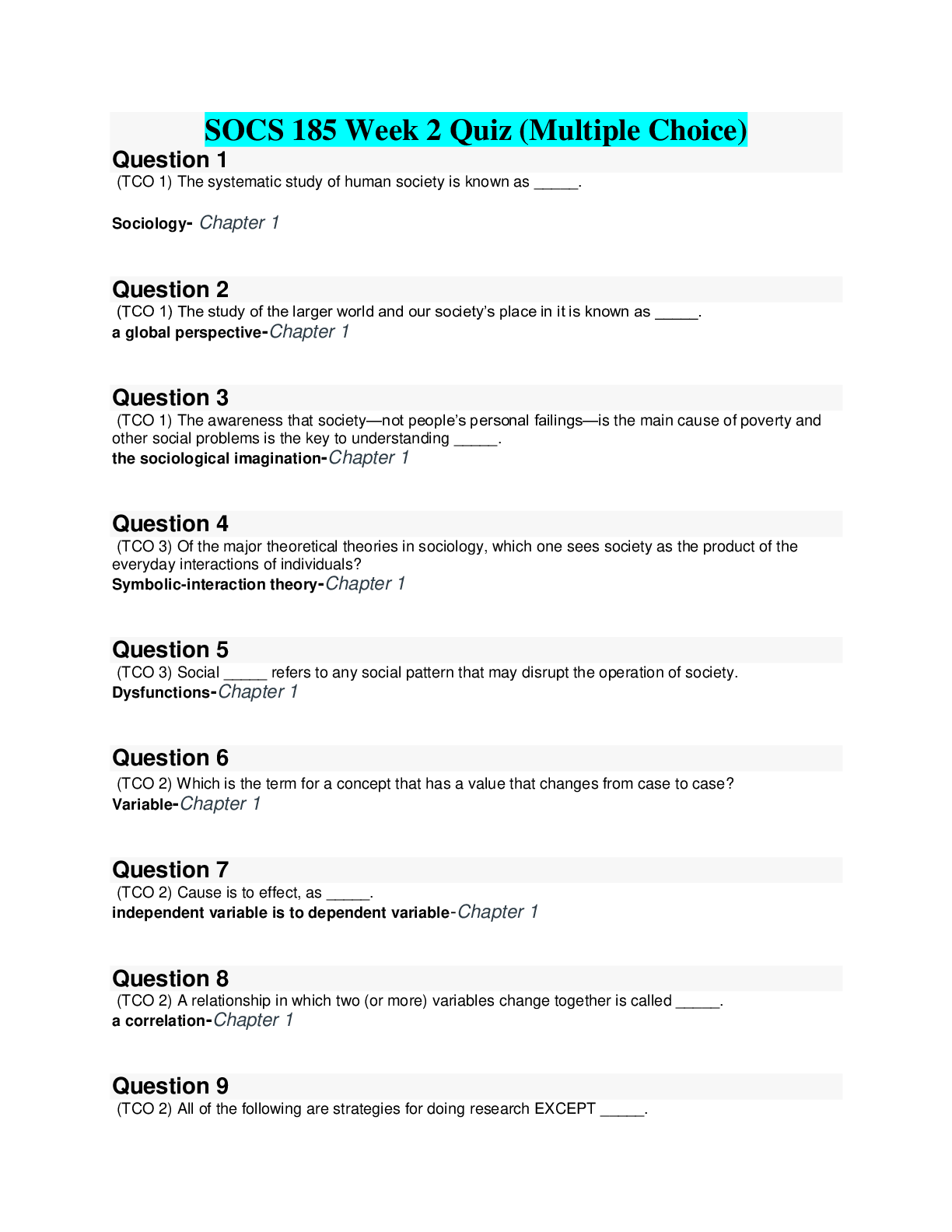NURSING 200: Comprehensive Exam 1. All answers correct. 100%.
Document Content and Description Below
Comprehensive Exam 1-Enalapril maleate (Vasotec) is prescribed for a hospitalized client. Which assessment does the nurse perform as a priority before administering the medication? A. Checking the... client's blood pressure B. Checking the client's peripheral pulses C. Checking the most recent potassium level D. Checking the client's intake-and-output record for the last 24 hours A client is scheduled to undergo an upper gastrointestinal (GI) series, and the nurse provides instructions to the client about the test. Which statement by the client indicates a need for further instruction? A. "The test will take about 30 minutes." B. "I need to fast for 8 hours before the test." C. "I need to drink citrate of magnesia the night before the test and give myself a Fleet enema on the morning of the test." D. "I need to take a laxative after the test is completed, because the liquid that I’ll have to drink for the test can be constipating." 2-A nurse on the evening shift checks a physician's prescriptions and notes that the dose of a prescribed medication is higher than the normal dose. The nurse calls the physician's answering service and is told that the physician is off for the night and will be available in the morning. The nurse should: A. Call the nursing supervisor B. Ask the answering service to contact the on-call physician C. Withhold the medication until the physician can be reached in the morning D. Administer the medication but consult the physician when he becomes available 4. An emergency department (ED) nurse is monitoring a client with suspected acute myocardial infarction (MI) who is awaiting transfer to the coronary intensive care unit. The nurse notes the sudden onset of premature ventricular contractions (PVCs) on the monitor, checks the client's carotid pulse, and determines that the PVCs are not resulting in perfusion. The appropriate action by the nurse is: A. Documenting the findings B. Asking the ED physician to check the client C. Continuing to monitor the client's cardiac status D. Informing the client that PVCs are expected after an MI 5. NPO status is imposed 8 hours before the procedure on a client scheduled to undergo electroconvulsive therapy (ECT) at 1 p.m. On the morning of the procedure, the nurse checks the client's record and notes that the client routinely takes an oral antihypertensive medication each morning. The nurse should: A. Administer the antihypertensive with a small sip of water B. Withhold the antihypertensive and administer it at bedtime C. Administer the medication by way of the intravenous (IV) route D. Hold the antihypertensive and resume its administration on the day after the ECT 6 A client who recently underwent coronary artery bypass graft surgery comes to the physician's office for a follow-up visit. On assessment, the client tells the nurse that he is feeling depressed. Which response by the nurse is therapeutic? A. "Tell me more about what you’re feeling." B. "That’s a normal response after this type of surgery." C. "It will take time, but, I promise you, you will get over this depression." D. "Every client who has this surgery feels the same way for about a month." 7 A client in labor experiences spontaneous rupture of the membranes. The nurse immediately counts the fetal heart rate (FHR) for 1 full minute and then checks the amniotic fluid. The nurse notes that the fluid is yellow and has a strong odor. Which of the following actions should be the nurse’s priority? A. Contacting the physician B. Documenting the findings C. Checking the fluid for protein D. Continuing to monitor the client and the FHR 8 A nurse has assisted a physician in inserting a central venous access device into a client with a diagnosis of severe malnutrition who will be receiving parenteral nutrition (PN). After insertion of the catheter, the nurse immediately plans to: A. Call the radiography department to obtain a chest x-ray B. Check the client's blood glucose level to serve as a baseline measurement C. Hang the prescribed bag of PN and start the infusion at the prescribed rate D. Infuse normal saline solution through the catheter at a rate of 100 mL/hr to maintain patency E. 9 A rape victim being treated in the emergency department says to the nurse, "I’m really worried that I’ve got HIV now." What is the appropriate response by the nurse? A. "HIV is rarely an issue in rape victims." B. "Every rape victim is concerned about HIV." C. "You’re more likely to get pregnant than to contract HIV." D. "Let's talk about the information that you need to determine your risk of contracting HIV." 10 A client is taking prescribed ibuprofen (Motrin), 300 mg orally four times daily, to relieve joint pain resulting from rheumatoid arthritis. The client tells the nurse that the medication is causing nausea and indigestion. The nurse should tell the client to: A. Contact the physician B. Stop taking the medication C. Take the medication with food D. Take the medication twice a day instead of four times 11 A client's oral intake of liquids includes 120 mL on the night shift, 800 mL on the day shift, and 650 mL on the evening shift. The client is receiving an intravenous (IV) antibiotic every 12 hours, diluted in 50 mL of normal saline solution. The nurse empties 700 mL of urine from the client's Foley catheter at the end of the day shift. Thereafter, 500 mL of urine is emptied at the end of the evening shift and 325 mL at the end of the night shift. Nasogastric tube drainage totals 155 mL for the 24- hour period, and the total drainage from the Jackson-Pratt device is 175 mL. What is the client's total intake during the 24-hour period? Type your answer in the space provided. Answer: ________mL Responses: "1670" 12 Lorazepam (Ativan) 1 mg by way of intravenous (IV) injection (IV push) is prescribed for a client for the management of anxiety. The nurse prepares the medication as prescribed and administers the medication over a period of: A. 3 minutes B. 10 seconds C. 15 seconds D. 30 minutes 13 A nurse, conducting an assessment of a client being seen in the clinic for symptoms of a sinus infection, asks the client about medications that he is taking. The client tells the nurse that he is taking nefazodone hydrochloride (Serzone). On the basis of this information, the nurse determines that the client most likely has a history of: A. Depression B. Diabetes mellitus C. Hyperthyroidism D. Coronary artery disease 14 Phenelzine sulfate (Nardil) is prescribed for a client with depression. The nurse provides information to the client about the adverse effects of the medication and tells the client to contact the physician immediately if she experiences: A. Dry mouth B. Restlessness C. Feelings of depression D. Neck stiffness or soreness 15 Risperidone (Risperdal) is prescribed for a client hospitalized in the mental health unit for the treatment of a psychotic disorder. Which finding in the client’s medical record would prompt the nurse to contact the prescribing physician before administering the medication? A. The client has a history of cataracts. B. The client has a history of hypothyroidism. C. The client takes a prescribed antihypertensive. D. The client is allergic to acetylsalicylic acid (aspirin). 16 A client who has been undergoing long-term therapy with an antipsychotic medication is admitted to the inpatient mental health unit. Which of the following findings does the nurse, knowing that long- term use of an antipsychotic medication can cause tardive dyskinesia, monitor in the client? A. Fever B. Diarrhea C. Hypertension D. Tongue protrusion 17 A nurse is reviewing the record of a client scheduled for electroconvulsive therapy (ECT). Which of the following diagnoses, if noted on the client's record, would indicate a need to contact the physician who is scheduled to perform the ECT? A. Recent stroke B. Hypothyroidism C. History of glaucoma D. Peripheral vascular disease 18 A client scheduled for suprapubic prostatectomy has listened to the surgeon's explanation of the surgery. The client later asks the nurse to explain again how the prostate is going to be removed. The nurse tells the client that the prostate will be removed through: A. A lower abdominal incision B. An upper abdominal incision C. An incision made in the perineal area D. The urethra, with the use of a cutting wire 19 A nurse is preparing a poster for a health fair booth promoting primary prevention of skin cancer. Which of the following recommendations does the nurse include on the poster? Select all that apply. A. Seek medical advice if you find a skin lesion. B. Use sunscreen with a low sun protection factor (SPF). C. Avoid sun exposure before 10 a.m. and after 4 p.m. D. Wear a hat, opaque clothing, and sunglasses when out in the sun. E. Examine the body every 6 months for possibly cancerous or precancerous lesions. 20 A nurse reviewing the medical record of a client with a diagnosis of infiltrating ductal carcinoma of the breast notes documentation of the presence of peau d'orange skin. On the basis of this notation, which finding would the nurse expect to note on assessment of the client’s breast? A. B. C. D. 21 The mother of an adolescent with type 1 diabetes mellitus tells the nurse that her child is a member of the school soccer team and expresses concern about her child's participation in sports. The nurse, after providing information to the mother about diet, exercise, insulin, and blood glucose control, tells the mother: A. To always administer less insulin on the days of soccer games B. That it is best not to encourage the child to participate in sports activities C. That the child should eat a carbohydrate snack about a half-hour before each soccer game D. To administer additional insulin before a soccer game if the blood glucose level is 240 mg/dL or higher and ketones are present 22 A client with chronic renal failure who will require dialysis three times a week for the rest of his life says to the nurse, "Why should I even bother to watch what I eat and drink? It doesn't really matter what I do if I’m never going to get better!" On the basis of the client's statement, the nurse determines that the client is experiencing which problem? A. Anxiety B. Powerlessness C. Ineffective coping D. Disturbed body image 23 A nurse is providing morning care to a client in end-stage renal failure. The client is reluctant to talk and shows little interest in participating in hygiene care. Which statement by the nurse would be therapeutic? A. "What are your feelings right now?" B. "Why don't you feel like washing up?" C. "You aren’t talking today. Cat got your tongue?" D. "You need to get yourself cleaned up. You have company coming today." 24 Empyema develops in a client with an infected pleural effusion, and the nurse prepares the client for thoracentesis. What characteristics of the fluid removed during thoracentesis should the nurse, assisting the physician with the procedure, expect to note? A. Clear and yellow B. Thick and opaque C. White and odorless D. Clear, with a foul odor 25 An emergency department nurse is told that a client with carbon monoxide poisoning resulting from a suicide attempt is being brought to the hospital by emergency medical services. Which intervention will the nurse carry out as a priority upon arrival of the client? A. Administering 100% oxygen B. Having a crisis counselor available C. Instituting suicide precautions for the client D. Obtaining blood for determination of the client’s carboxyhemoglobin level 26 A nurse is caring for a client with sarcoidosis. The client is upset because he has missed work and worried about how he will care financially for his wife and three small children. On the basis of the client's concern, which problem does the nurse identify? A. Anxiety B. Powerlessness C. Disruption of thought processes D. Inability to maintain health [Show More]
Last updated: 2 years ago
Preview 1 out of 7 pages
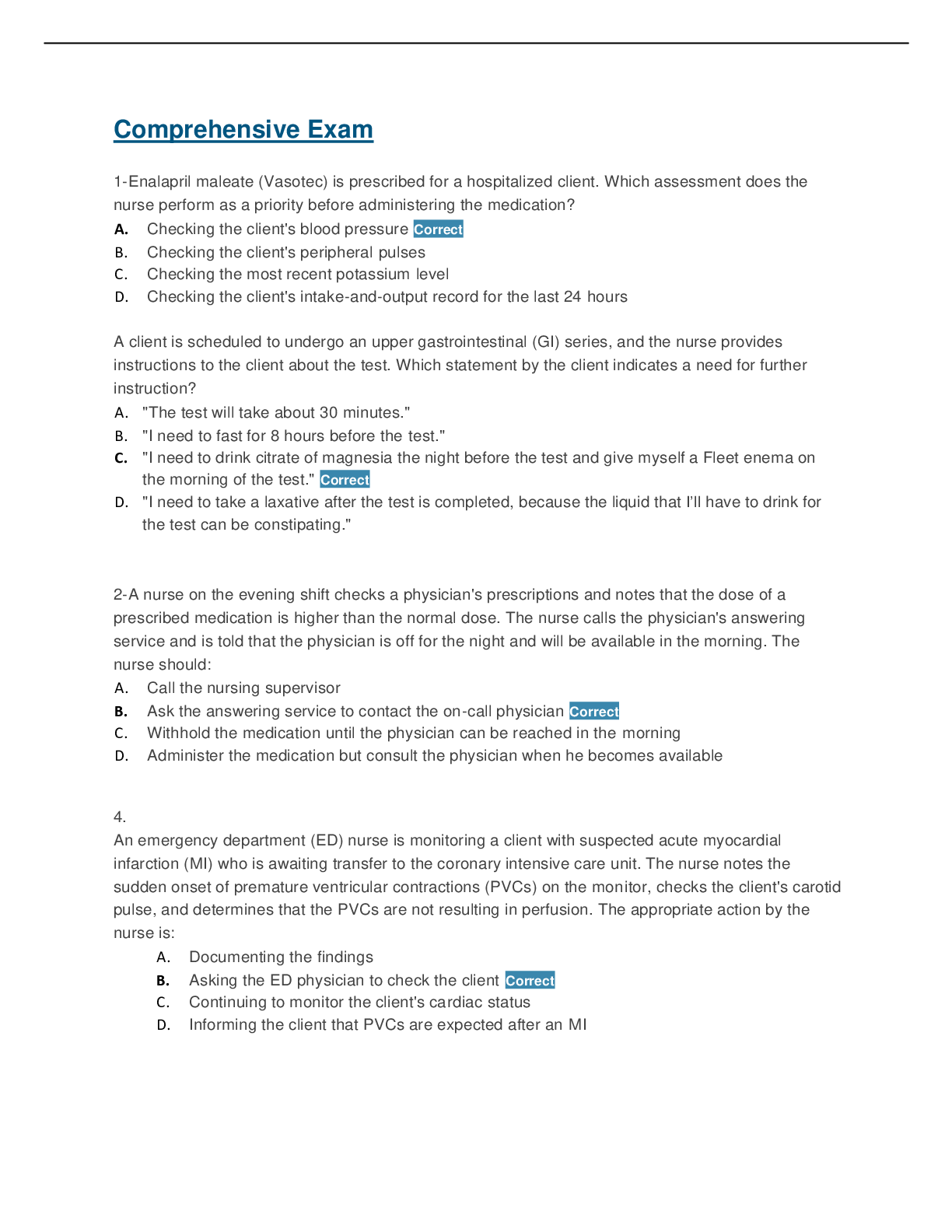
Buy this document to get the full access instantly
Instant Download Access after purchase
Buy NowInstant download
We Accept:

Reviews( 0 )
$9.00
Can't find what you want? Try our AI powered Search
Document information
Connected school, study & course
About the document
Uploaded On
Aug 20, 2020
Number of pages
7
Written in
Additional information
This document has been written for:
Uploaded
Aug 20, 2020
Downloads
0
Views
165

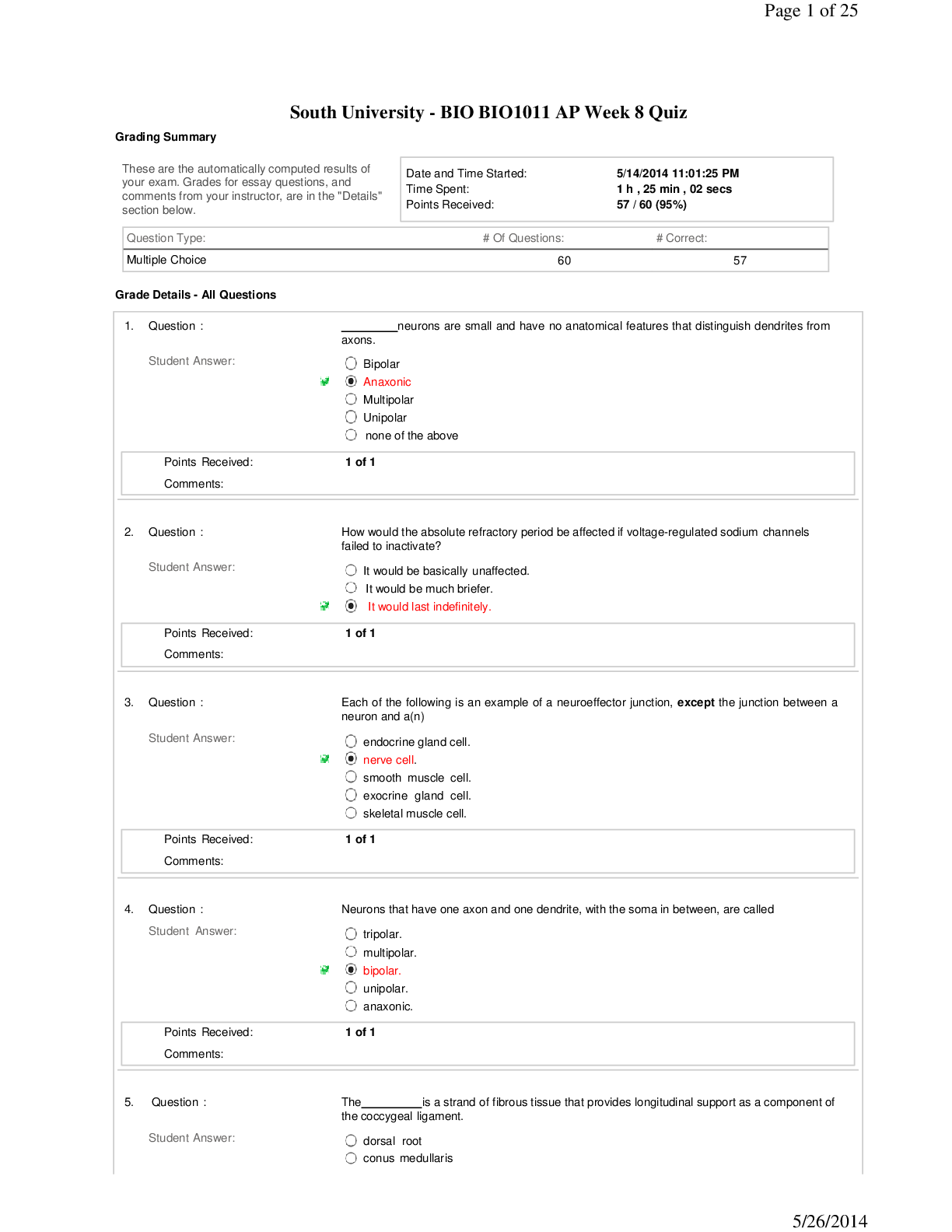
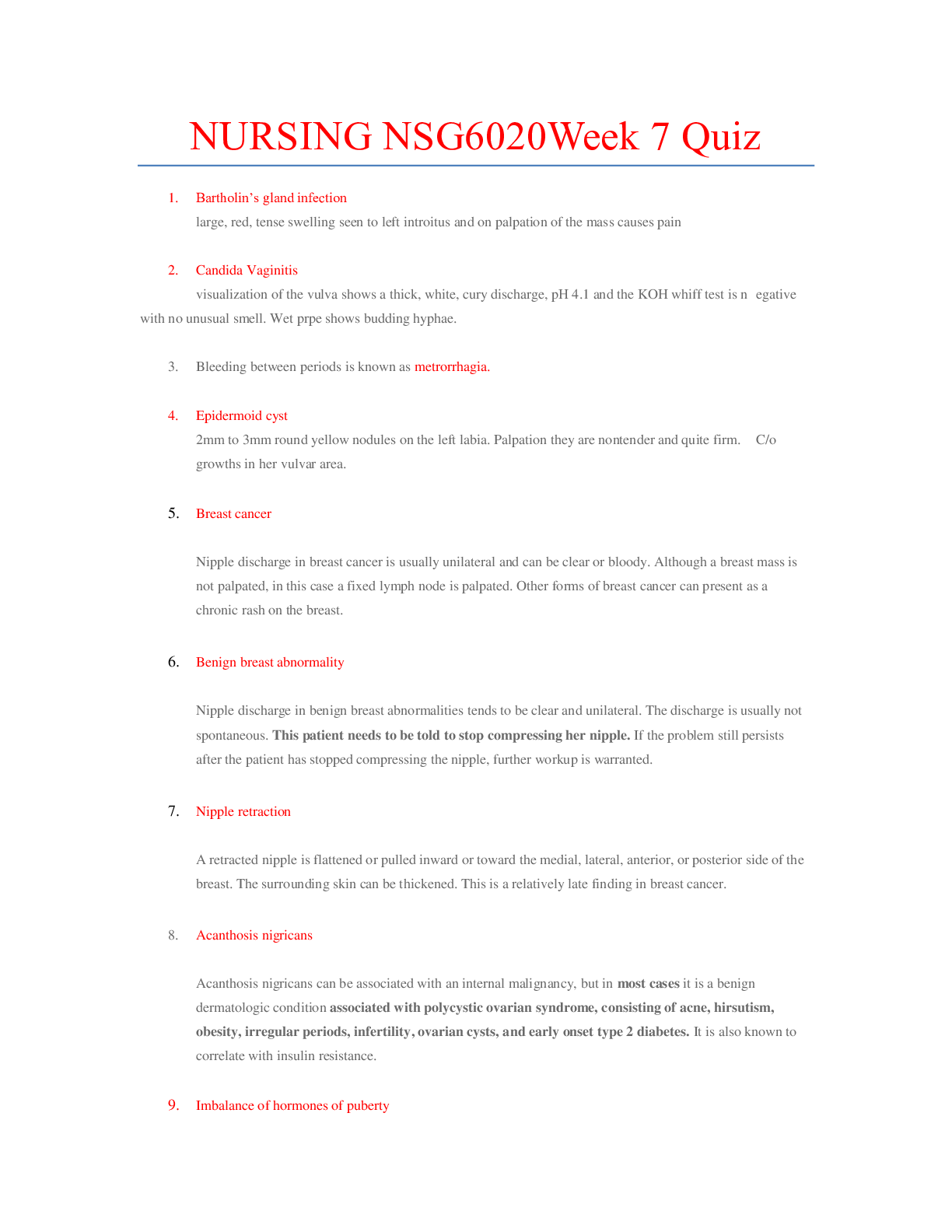
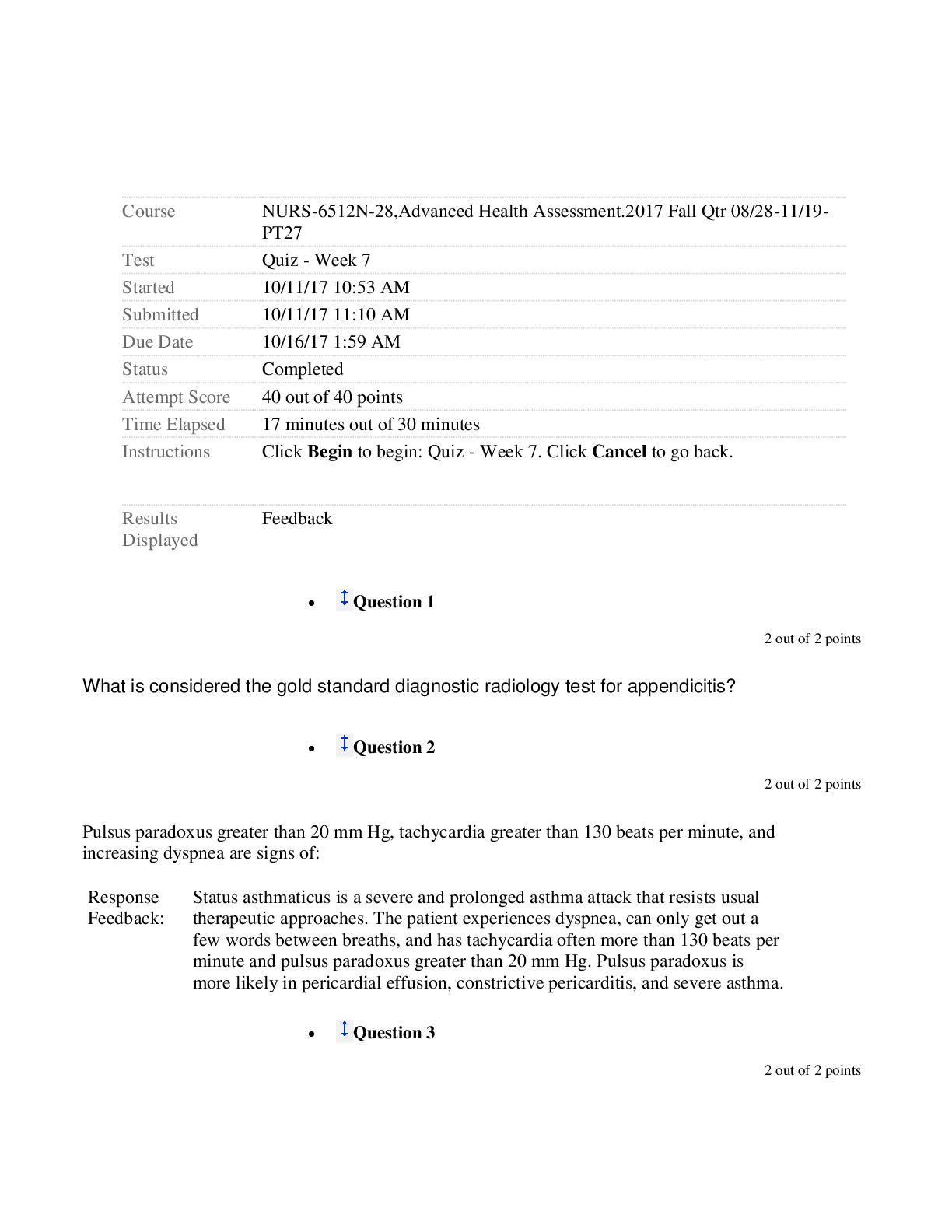



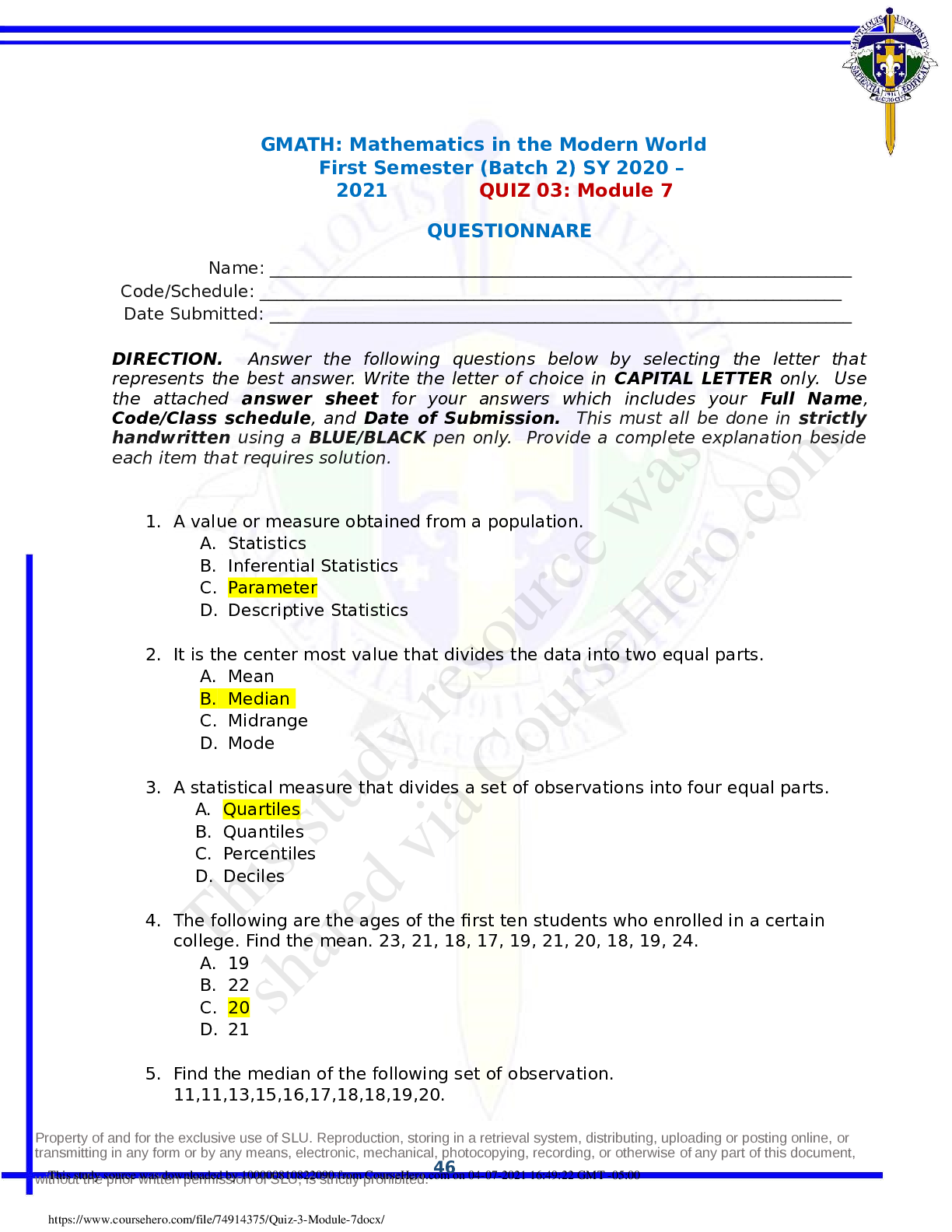



.png)










